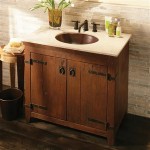Bathroom Sink Drain Line Size: A Guide to Proper Plumbing
A bathroom sink drain line is an essential part of your plumbing system, ensuring that water flows away from your sink and prevents unwanted water buildup. The size of the drain line is crucial for its proper functioning. A line that is too small can lead to slow drainage, while a line that is too large can result in inefficient water usage. Understanding the factors that influence drain line size and the standard dimensions used in bathroom plumbing is vital for ensuring a smoothly functioning bathroom sink.
This article serves as a guide to help homeowners and plumbers understand the importance of properly sized bathroom sink drain lines. It provides information on the factors influencing drain line size selection and the standard dimensions commonly used in residential plumbing. This knowledge will empower you to make informed decisions regarding your bathroom sink plumbing, ensuring optimal performance and avoiding potential issues.
Factors Influencing Drain Line Size
Several factors determine the appropriate size of a bathroom sink drain line. These factors ensure that the plumbing system can effectively handle the volume of water draining from the sink. By taking these factors into consideration, you can choose the correct drain line size and avoid clogging or other plumbing problems.
1. Sink Size and Type
The size and type of the bathroom sink directly impact the drain line size requirement. Larger sinks or sinks with a larger basin area generate a larger volume of water per drain cycle. For instance, a large double vanity sink would require a larger drain line than a smaller, single-bowl vessel sink. The type of sink also matters, with pedestal sinks often having smaller drain lines compared to countertop sinks.
2. Number of Sinks
The number of bathroom sinks connected to a single drain line also influences its size. If multiple sinks share a single drain line, a larger diameter pipe is recommended to handle the combined water flow. This ensures a consistent flow and prevents a slowdown in drainage due to the increased volume of water.
3. Water Pressure
The water pressure in your home can also influence the size of your drain line. Higher water pressure generates a more forceful flow, requiring a larger pipe to accommodate the increased volume. This is particularly important to consider when designing plumbing for areas with high water pressure.
Standard Drain Line Sizes
Standard bathroom sink drain lines typically range in size from 1-1/2 inches (38 mm) to 2 inches (51 mm) in diameter. The most common size for residential bathroom sinks is 1-1/2 inches. This size provides a balance between sufficient drainage capacity and cost-effectiveness. However, as discussed earlier, specific factors can necessitate the use of larger diameter pipes.
Consequences of Improper Drain Line Sizing
Using an incorrectly sized drain line can lead to various plumbing issues, causing inconvenience and potentially costly repairs. Understanding the potential problems associated with improper sizing can help homeowners and plumbers identify and mitigate these risks.
1. Slow Drainage
A drain line that is too small can restrict water flow, resulting in slow drainage. Water may accumulate in the sink bowl, creating a nuisance and potentially overflowing. Slow drainage can also create unpleasant smells and promote the growth of bacteria in the plumbing system.
2. Clogging
Smaller drain lines are more susceptible to clogging, as they offer less space for waste to pass through. Hair, soap scum, toothpaste, and other debris can collect in the line, obstructing water flow and leading to a complete blockage.
3. Plumbing Damage
A drain line that is too small can put excessive pressure on the plumbing system. This increased pressure can cause damage to the pipes, leading to leaks and costly repairs.
4. Inefficient Water Usage
While an undersized drain line can lead to problems, a drain line that is too large can also be problematic. A larger drain line can result in inefficient water usage, as it allows water to flow through too quickly. This can lead to increased water bills and unnecessary water waste.
Conclusion
Properly sizing bathroom sink drain lines is essential for ensuring efficient and trouble-free plumbing. By taking into account factors such as sink size, number of sinks, and water pressure, homeowners and plumbers can determine the appropriate drain line size for their specific needs. Understanding the potential consequences of improper sizing can help identify and mitigate potential plumbing problems, ensuring a durable and functional bathroom sink.

How To Plumb A Bathroom With Multiple Plumbing Diagrams Hammerpedia

How To Vent A Toilet Sink And Shower Drain

Maximum Length For Fixture Drains Jlc

Gordee Bathroom Basin Sink Bottle P Trap Brass U Shape 1 4 Inch Slip Inlet Drain Lavatory Adjustable Height Waste Kit Pls Measure Ur Hole Size Before Order Matte Black

This Image To Show The Full Size Version Sink Plumbing Kitchen Diy

Snappytrap Universal Drain Kit For Bathroom Sinks Dk 105 The Home Depot
Is The Same Pipe Used For Drainage From A Sink Shower And Toilet Quora

Bathroom Sink P Traps Sanliv Sanitary Wares
Is The Same Pipe Used For Drainage From A Sink Shower And Toilet Quora

Snappytrap Snappy Trap Universal Drain Kit For Bathroom Sinks Black Adapts To 1 4 In 2 Sink Drains And Wall Pipes The Under Plumbing Department At Com
Related Posts







